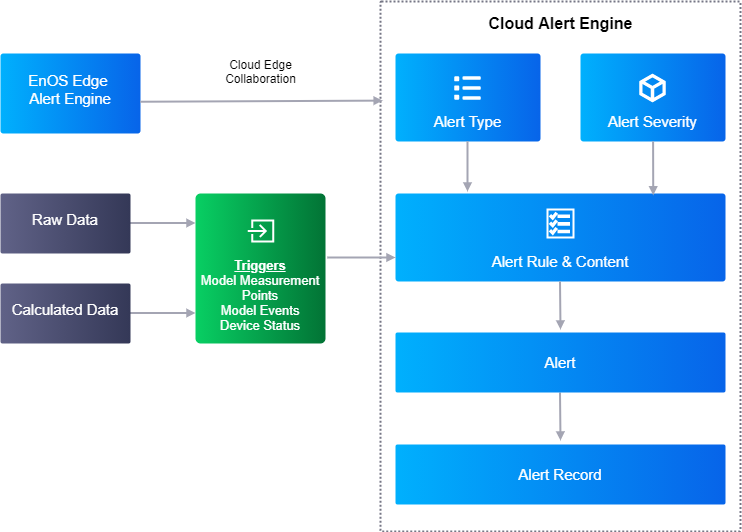Alert Management Overview¶
The EnOS Asset Alert Management service enables you to define, receive, and process alerts for your organization assets. The service also allows you to define alert triggering rules for the asset data to achieve real-time alerting and troubleshooting.
Key Concepts¶
An alert is a record generated by the system when certain conditions specified by the user are met.
Triggers are defined using conditions in alert rules to trigger the alert, and alert content will be returned when alerts are triggered. To distinguish and manage the alerts more effectively, alerts on EnOS are typically classified based on the severity (such as danger, critical, error, warning, and information) and type (such as over-limit).
The alert management message flow and the key concepts are illustrated in the following figure.

Major Functions¶
Forward alert data to EnOS in a standard data structure
The alert management service defines the standard alert data structure and alert receiving interfaces to allow alert data to be transmitted to EnOS Cloud in real-time or in batch processing mode. For EnOS Cloud to be able to process the alert data, you must use the alert management service to define the standard alert data structure that is accepted by EnOS.
Support the definition of alert triggering rules and generated content
The alert management service allows you to define alert triggering rules for specific data measurement points, events, or device status. For example, you can define an over-limit rule that will trigger an alert when the value of the measurement point exceeds a threshold.
For devices such as wind turbines, photovoltaic inverters, and booster stations, you can define alert triggering rules for data acquisition points (for example, when the engine room temperature exceeds 45 degrees centigrade, or when a short-circuit occurs in the booster station) to meet the real-time monitoring, subsequent diagnosis, and troubleshooting requirements.
Meanwhile, you can define alert severities and alert types according to the best practices of a domain. For example, you can define alert types such as communication abnormality and performance degrading. You can also define the typical alert severities (information, warning, and error) according to your business requirements.
Support query, subscription, and push alert data from EnOS
The alert management service provides APIs for alert data related actions such as querying, subscribing, and pushing alerts. You can develop your own alarming applications or perform analytics based on these APIs. By subscribing to alerts and integrating with an email or message service, you can also develop your own alarming applications such as alert pop-ups, real-time and historical alert inquiry, and email and message alerts. For more information about data subscription, see Data Subscription.
Support the integration of third-party alert data
EnOS can also accept alert data that are generated from third-party systems. For example, in the ship-building industry, the on-site SCADA can forward the alert data received from the ship communication network to EnOS in a standard alert data format. You can then use the EnOS alert management service APIs for your alert related applications.
Note
For assets connected through MQTT, alerts are not generated by default even after you configure the alert triggering rules for the assets. To generate alerts for such assets, the alert engine must be configured. Contact your Envision project manager or system administrator for alert engine configuration requests.